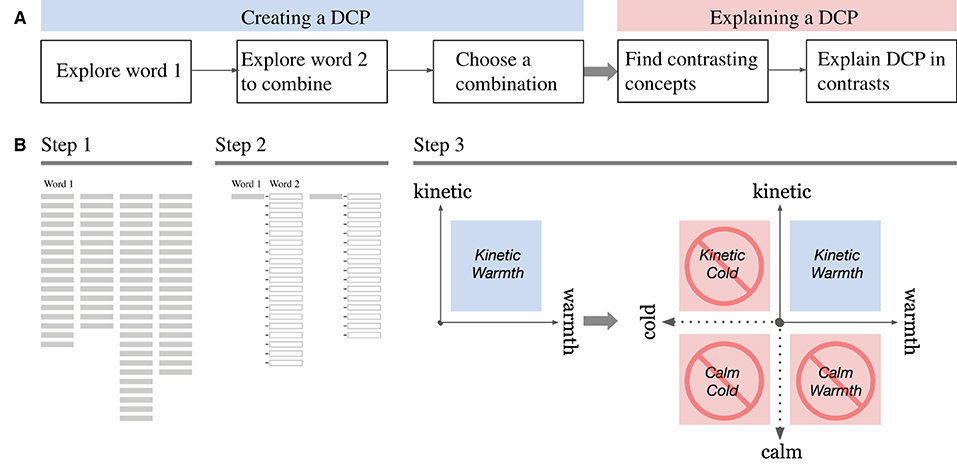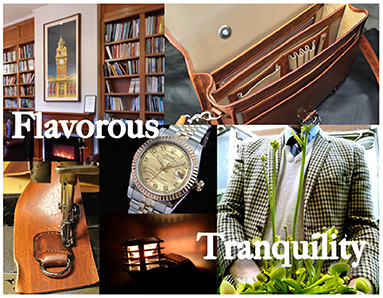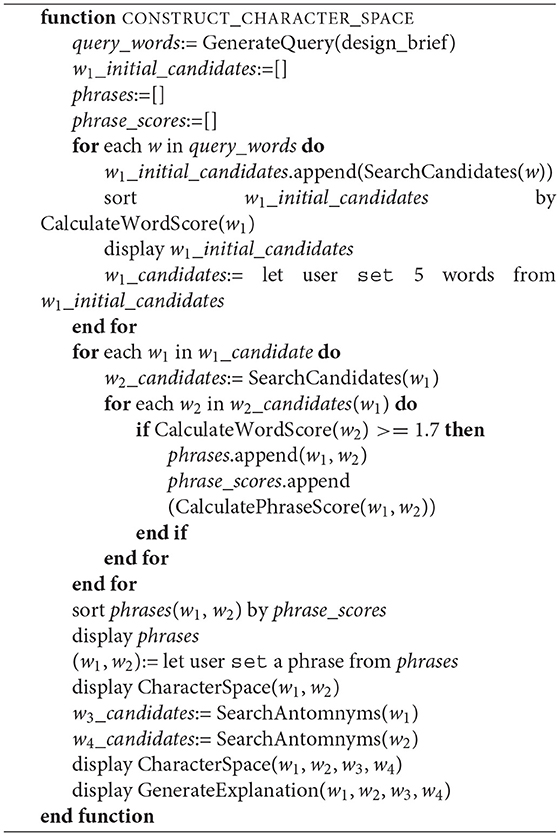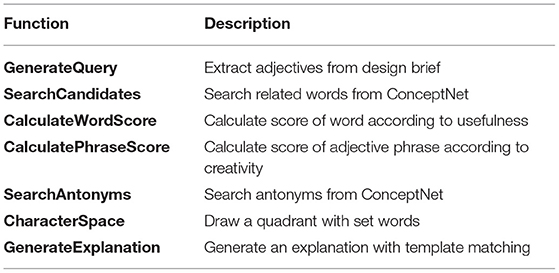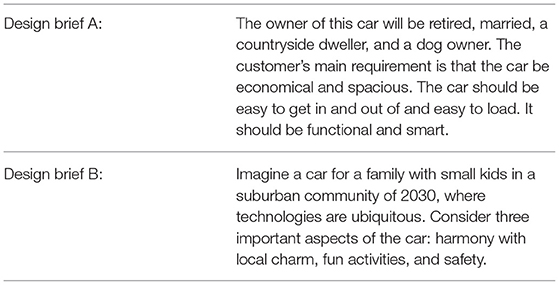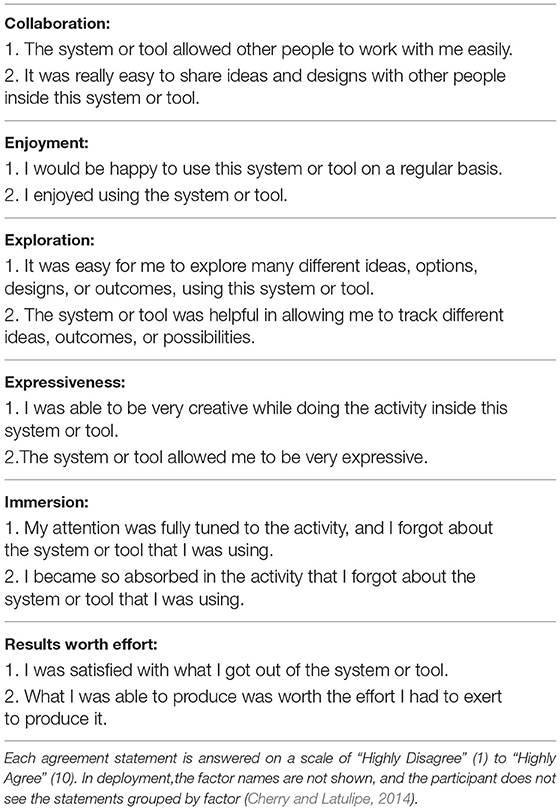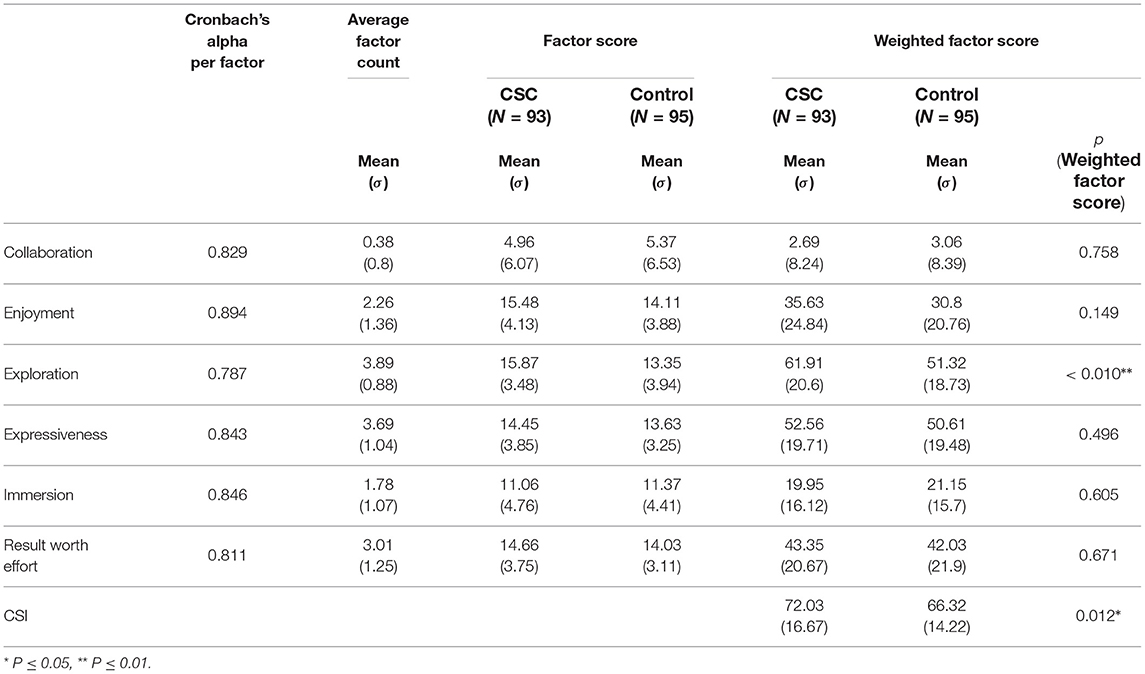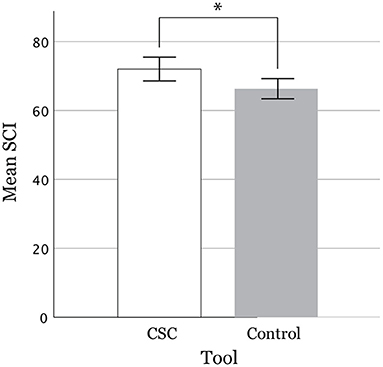- 1Department of Informatics, School of Multidisciplinary Sciences, Graduate University for Advanced Studies (SOKENDAI), Hayama, Japan
- 2Institute for Creative Integration, Oakland, CA, United States
- 3Digital Content and Media Sciences Research Division, National Institute of Informatics, Tokyo, Japan
We propose an AI-assisted design concept exploration tool, the “Character Space Construction” (“CSC”). Concept designers explore and articulate the target product aesthetics and semantics in language, which is expressed using “Design Concept Phrases” (“DCPs”), that is, compound adjective phrases, and contrasting terms that convey what are not their target design concepts. Designers often utilize this dichotomy technique to communicate the nature of their aesthetic and semantic design concepts with stakeholders, especially in an early design development phase. The CSC assists this designers' cognitive activity by constructing a “Character Space” (“CS”), which is a semantic quadrant system, in a structured manner. A CS created by designers with the assistance of the CSC enables them to discern and explain their design concepts in contrast with opposing terms. These terms in a CS are retrieved and combined in the CSC by using a knowledge graph. The CSC presents terms and phrases as lists of candidates to users from which users will choose in order to define the target design concept, which is then visualized in a CS. The participants in our experiment, who were in the “arts and design” profession, were given two conditions under which to create DCPs and explain them. One group created and explained the DCPs with the assistance of the proposed CSC, and the other did the same task without this assistance, given the freedom to use any publicly available web search tools instead. The result showed that the group assisted by the CSC indicated their tasks were supported significantly better, especially in exploration, as measured by the Creativity Support Index (CSI).
1. Introduction
Our research is motivated by an observation in the professional industrial design domain and a research question derived from it: “could concept designers' creative activities, especially verbalizing novel design concept phrase, be modeled and computationally supported?” The concept design used in industrial design is primarily concerned with developing the aesthetics and semantics of products (Krippendorff, 2005). The visual appearance and meaning behind a product is frequently a key attribute of a product's appeal to consumers (Bloch et al., 2003; Alcaide-Marzal et al., 2020; Han et al., 2021), as the functionality of a product is increasingly taken for granted, and users are looking for different levels of appreciation (Demirbilek and Sener, 2003). Consequently, designers are in charge of not only creating the visual appearance of products but also verbally articulating the product semantics and emotional feelings attached to them (Dong, 2005). Design concepts articulated using this verbal mode often have to be explored, communicated, understood, and approved by the project stakeholders during a design project. Krippendorff (2005) called this practice a “design discourse,” describing, “Designers have to justify the aesthetics of mass-produced products, products that would ideally be of use to everyone, not individual works of art.” This characterizes the special role industrial designers play, as distinguished from engineering designers, and this role is most clearly observable in the automobile industry (Tovey, 1992).
While emotional components in industrial design are important (Desmet and Hekkert, 2002; McDonagh et al., 2002; Norman, 2004), automotive customers especially value emotional experiences when they own and use products, such as those related to their self-image and brand messages reflected in vehicles (Hekkert, 2006; Helander et al., 2013). Designers and other stakeholders exchange views on the form of a vehicle design as part of the design process. Tovey (1992) characterized the language they use as “idiosyncratic and atypical,” requiring them to explore and communicate different shapes and features in words, such as “slippery,” “exciting,” “fluid,” “tailored,” and “sheer.” Such language used in car design studios describes particular forms or connotes a “feeling.” Bouchard et al. (2005) described these verbal expressions as “intermediate representations” that will eventually be translated into visual aesthetic and semantic features of product designs. Designers in practice often feel that they run out of these words to express different design concepts in different projects.
The present research attempts to uncover professional concept designers' cognitive activities, that are traditionally highly empirical and undocumented, for when they explore and form such verbal representations of design concepts and also attempts to computationally support the process by an AI algorithm. The contributions of this research are as follows:
• We defined concept designers' cognitive activities in exploring, generating, and explaining a design concept with a “Design Concept Phrase” (“DCP”) and contrasting concepts, and modeled this process as constructing what we call a “Character Space” (“CS”).
• We implemented this model of constructing a CS into an AI algorithm and created an interactive system, which supports concept designers' creative process described above.
• We defined a DCP as a compound phrase using an adjective-“noun-form-of” adjective formula.
In this paper, we will first discuss the background of the topic space together with related works. We will highlight how professional concept designers utilize a verbal mode of exploration to generate and communicate novel design concepts in the early stage of the design process, especially with an emphasis on their process of using a dichotomy technique, taking as an example the development of an automotive design concept. Then, we propose an AI-assisted interactive system, “Character Space Construction” (“CSC”), and its methodologies, utilizing the quadrant system, that is, the CS, for designers to generate and use DCPs. Last, we introduce our experiment with participants in design profession to measure the effectiveness of the tool, followed by discussions.
We illustrate a case study of how they use DCPs from an automotive design, however, these adjective phrases are used in the practice of industrial design in general (Shieh et al., 2011), fashion design (Choo and Kim, 2003), furniture design (Khalaj and Pedgley, 2014), or even in the tourism industry (Durán-Muñoz, 2019). Therefore, the proposed methods can contribute to various design and marketing fields.
2. Background
2.1. Defining Design Concept Phrase and Character Space
First, we define the “Design Concept Phrase” (“DCP”) as a compound adjective phrase that conveys product aesthetics and semantics. In the industry, such phrases are sometimes called “keywords” (Nagai and Noguchi, 2003); however, we call them DCP in this research since the term “keywords” is used differently in the natural language processing (NLP) context. A DCP, “kinetic warmth,” for example, was created by the designers at Toyota's North American design studio for Concept-i (Figure 1B). Note that the noun “warmth” was converted into a noun from the adjective “warm.” Ian Cartabiano, the chief designer of Concept-i at Toyota's Calty Design Research studio explained, “There's a school of design at the moment which makes a car feel just like a laptop on wheels, an impersonal transport unit. We wanted to do something more soulful, intriguing, lively, and human.” When they identified “kinetic” and “warmth,” the design team explored other terms, such as “dynamic,” “engaging,” “intriguing,” “soulful,” “human,” “lively,” and “passionate”1. Notice that Cartabiano expressed a type of aesthetics and semantics to be avoided, that is, “a laptop on wheels, an impersonal transport unit.” They later put those feelings into two other contrasting terms, “calm” and “cold,” and placed them onto a quadrant system, which we define in this research as the “Character Space” (“CS,” Figure 1A). These contrasting terms make “kinetic warmth” understanable by stating what is NOT “kinetic warmth.”
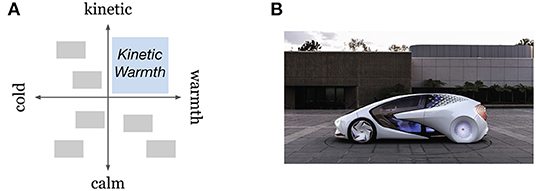
Figure 1. (A) Character space (CS) for “kinetic warmth.” (B) Toyota Concept-i design derived from “kinetic warmth” (©2021 Toyota Motor Sales, U.S.A., Inc.).
A CS visually resembles a dimensionality reduction on 2D semantic space employing multidimensional scaling (MDS); however, the way a CS is formed in practice fundamentally differs from how an MDS is formed. A CS is informally utilized as a synthesis tool employing a quadrant system, on which a user identifies each end of the axis through creative exploration and speculation. The primary focus is the upper-right quadrant, which represents the target concept expressed by a compound adjective; then, the other quadrants will be defined as the user identifies opposite terms to each of the compound adjectives (e.g., “kinetic-calm” and “warm-cold”). These polar terms on the axes consequently form semantic differentials (Osgood et al., 1957), however in a CS, the two terms in an orthogonal relationship (e.g., “kinetic” on the vertical axis and “warm” on the horizontal axis) are identified first before a pair of polar terms on a semantic differential is defined. Also, that these polar terms can be defined by the designers as a part of creation depending on what aspect of a particular adjective they want to emphasize. For instance, an adjective, “beautiful,” can be perceived differently depending on the term at the other end (e.g., “beautiful”↔“ugly” or “beautiful”↔“practical”). A CS is completed when all four ends on the axes are defined. In this research, we label the top end of the vertical axis as word 1 (w1), and the rest are then labeled in clockwise order as word 2 (w2), word 3 (w3), and word 4 (w4). The upper-right quadrant, represented by the combination of w1 and w2, is the target design-concept phrase. All the other quadrants, represented by w2-w3, w3-w4, and w4-w1, are contrasting concepts to be used to explain the target DCP in terms of how and by which attributes they differ and what already exists or what is to be avoided.
Meanwhile, a multidimensional scaling with MDSs has been widely used as an analytical tool since first being introduced by Ramsay (1975) and became a popular data visualization tool when Zimet et al. (1988) used them in the form of the Multidimensional Scale of Perceived Social Support (MSPSS). MDSs have been successfully implemented in new product development domains, including concept mapping (Trochim, 1989) and kansei engineering (Nagamachi, 1995). They visualize the spatial distance between individual cases of a data set according to similarities. The usage of MDSs first involves collecting data on the basis of ratings of statements or semantic differentials for each case, followed by dimensionality reduction done by using statistical techniques, such as principal component analysis (PCA), to yield a scatter plot visualization of the cases on a two-dimensional space. After a visualization with an MDS users usually have to define the labels of the axes by interpreting the collective meanings of the distantly-plotted clusters on an MDS. Therefore, a dimensionality reduction is a methodologically different process from the CS, which we attempt to define in this research.
2.2. Compound Adjective Phrase
While our goal is to address product aesthetics and semantics that evoke end users' emotional feelings attached to them, we focused on adjectives that describe the emotional aspects of product designs. Hsiao and Chen (2006) conducted surveys using product images and adjectives on semantic differentials. The factor analyses identified four main dimensions of the participants' emotional responses to product shapes, characterized by the pairs of polar affective adjectives. They demonstrated the role of adjectives in product designs, yet their focus was not to explore a variety of nuanced adjectives to describe a unique design concept.
In order to describe distinct quality of a design aesthetics and semantics, we chose to use adjective-adjective combinations. This is called a compound adjective in a coordinated sequence—a sequence in which two or more adjectives severally restrict the head noun (e.g., a tall thin woman). In this example, the phrase therefore means a “woman who is both tall and thin.” The criteria for being coordinated and in a sequence is that the adjectives in a coordinated sequence may, but need not, be linked by “and.” Also, a change in the order of adjectives in a coordinated sequence may result in a shifting of the emphasis, or even in a stylistic flaw, but will not change the meaning of the phrase (Sopher, 1962). In addition, the second adjective takes the noun form (e.g., “kinetic warm” → “kinetic warmth,” “effortless elegant” → “effortless elegance,” “fluid beautiful” → “fluid beauty”) in order for the phrases to sound complete by themselves. In the case of “kinetic warm(th),” the complete phrase would be “kinetic and warm style” or “kinetic and warm car”; however, since the head nouns “style” or “car” are obvious in the context, they are omitted. Therefore, the type of phrase we use in this research can be defined as a compound adjective (adjective + adjective) phrase in a coordinated sequence, which is modified to an adjective-noun form. This type of compound phrase is underexplored in the research topic called “combinational creativity.”
Combinational creativity attempts to produce new ideas by combining existing ideas in unfamiliar ways (Boden, 2001). A number of studies have identified the effect of combinational creativity as a tool for generating creative design concepts (Georgiev et al., 2010; Chiu and Shu, 2012; Han et al., 2020). Nagai et al. (2009), in a collaboration with designers, suggested that a new concept can be created by synthesizing two ideas in noun-noun combination phrases. Chiu and Shu (2012) used oppositely and similarly related pairs of words as stimuli for design-concept generation and observed that oppositely related verb-verb combination stimuli could increase concept creativity. The Combinator (Han et al., 2016) imitates the way the human brain achieves combinational creativity and suggests combined ideas in both visual and textual representations. In these works, combinational creativity focused either on combined product categories or objects derived from noun-noun combinations (e.g., “desk + elevator” or “pen + ruler”) or functional features derived from verb-verb combinations (e.g., “fill + insert”), and they did not address product aesthetics.
2.3. Lexico-Semantic Exploration Tool
In constructing a CS in our system, we use the ConceptNet knowledge graph (Speer et al., 2017) for exploring compound phrases. ConceptNet is a knowledge graph that connects words and phrases with labeled edges. It is designed to represent varieties of general knowledge to allow users to make word associations and make sense of the meanings behind them. Its knowledge is collected from a wide range of sources, such as expert-created resources, crowd-sourcing, and games with a purpose. Among creativity support tools, Spinneret (Bae et al., 2020) uses ConceptNet and provides idea suggestions as nodes on a graph. It aims to support divergent thinking, and it explores ideas and provides “suggestions” to the user to add to a mind map. Mini-Map (Chen et al., 2019) also uses ConceptNet, and it gamifies collaborations with an intelligent agent in creating a mind map. The both studies chose the ConceptNet as to be suitable for enhancing explorations and mitigating fixation during an ideation process.
2.4. Metrics of Creativity Support Tools
Unlike productivity support tools that can be evaluated on the basis of objective metrics, the evaluation of creativity support tools lacks obvious metrics, and there is no one-size-fits-all approach (Hewett et al., 2005). In one of the several dimensions of creativity that Sternberg (1999) discussed, creativity can be a property of people, a property of products, and a property of a set of cognitive processes. With respect to a property of products, “originality” and “effectiveness” are popular criteria (Stein, 1953; Barron, 1955; Runco and Jaeger, 2012). Both terms have versions of labels, such as “novelty,” “unusuality,” or “uniqueness” for the former and “usefulness,” “practicality,” “appropriateness,” or “relevancy” for the latter (Bruner, 1962; Kneller, 1965; Cropley, 1967). They are measured either on the basis of self-report evaluation or rated by experts with the precaution of the inter-rater disagreement. With respect to evaluating a property of people, it tends to lead to a concern with individual differences between people.
In this research, we used the Creativity Support Index (CSI) (Cherry and Latulipe, 2014), which covers the two properties of creativity above, that are, a property of products, and a property of a set of cognitive processes, both in terms of users' own perceptions. This would be suitable for the present research, especially when the objective is to cater a tool, which is designed with certain functional requirements in mind, to support the effectiveness of designers' cognitive processes. We will discuss the further details of the CSI, its benefits and application in Section 4.3.
3. Method
3.1. Preliminary Study for Adjective-Adjective Compound Phrases
As discussed in Section 2.2, we intend to use compound adjective phrases for the DCP. Despite the fact that some related works demonstrated the role of adjectives in conveying users' emotional responses to product aesthetics (Hsiao and Chen, 2006), or the effectiveness of combinational creativity (Hsiao and Chen, 2006), this particular type of combinational phrase is under-researched in the context of supporting designers' creativity, there is no prior work that demonstrated the effectiveness of adjective-adjective compound phrase compare to different types with other parts-of-speech (PoS), such as noun-noun or verb-verb. Thus, we conducted a preliminary experiment comparing phrases with different PoS to confirm that adjective phrase combinations are suitable for communicating product aesthetics.
We used Survey Monkey to recruit 55 participants whose job function is “arts and design.” Six sample phrases were randomly generated for each of four different combinations of PoS: adjective-adjective (AA), adjective-noun (AN), noun-noun (NN), and verb-verb (VV). For the selection of these words, we randomly extracted the words for all combinations from a corpus, which we created with English automotive design articles containing about 1.4 million words on Sketch Engine (Kilgarriff et al., 2004). The following filtration was performed equally for all PoS combinations. First, we removed non-English terms and proper nouns and then removed words whose relative frequency per a million tokens was <1.0, compared with enTenTen15 (Jakub́ıček et al., 2013), a large web text corpus containing about 1.6 billion words. This made the list of all words, regardless of PoS, more suitable for designing concept expressions that participants can readily recognize and make a judgment about. The participants rated 24 randomly generated two-word combinational phrases in randomized order on a 7-point Likert scale on the basis of the degree to which they agreed with the statement “I can imagine the product aesthetics, characters, mood, and emotional quality that are conveyed by the product design.” An ANOVA-Tukey test identified homogeneous subsets as [AA/AN/NN] and [VV/NN], where the mean score of the former was significantly higher (p = 0.05*). Therefore, using adjective-“noun-form-of” adjective phrases, as opposed to using noun-noun or verb-verb phrases, would yield optimized effect on addressing product aesthetics and semantics, as well as emotional qualities attached to them we are trying to accomplish in this research.
Further details on the individual comparisons are as follows. There was a significant difference (p = 0.038*) in mean scores between AA (3.890, σ = 1.121) and VV (3.300, σ = 1.205), a significant difference (p = 0.040*) between AN (3.885, σ = 1.025) and VV, no significant difference (p = 0.581) between AA and NN (3.612, σ = 1.232), no significant difference (p = 0.599) between AN and NN, no significant difference (p = 0.485) between NN and VV, and no significant difference (p = 1.000) between AA and AN.
3.2. System Overview
The present system, Character Space Construction (CSC), is an AI-assisted interactive system. A new contribution of the CSC is that it helps designers to construct a two-dimensional CS as a quadrant system, which yields a DCP, a compound adjective phrase, that portrays a design concept and explains it in semantic comparisons. The CSC is a web application that has all the functions above in one system and is operated in an interactive manner. The algorithm of the system, which constructs a CS by letting the user set four words (w1-w4), will be discussed in detail in Section 3.3. The CSC application consists of a front-end web application written in JavaScript, HTML, and CSS and a back-end web server written in Python with a MySQL database hosted on PythonAnywhere, which is a hosting service for Python web applications. The MySQL database was built on PythonAnywhere and holds the data of word embeddings from the ConceptNet Numberbatch (Speer et al., 2017).
3.3. Character Space Construction Algorithm
As discussed in Section 2.1., some concept designers empirically use a CS as a synthesis tool, not as an analytical tool, in a process of forming a DCP. On a quadrant system, two terms in the upper right quadrant are identified first then the opposite term on each vertical and horizontal axis are identified. This unique process has not been formalized in the past to the best of our knowledge. Figure 2A illustrates the sequence of designers' cognitive activities. It starts with searching and selecting a few candidates of the first words of a compound adjective, followed by searching and identifying the second adjective to be combined with the candidates of word 1. Once word 1 and word 2 are identified as a DCP, designers then attempt to find contrasting words for each to explain the DCP in comparison to those terms, with or without CS. Figure 2B shows the process model of constructing a CS in sequence, replicating the process in Figure 2A in a structured manner. A formalization of constructing a CS not only clarifies the designers' process of verbal design concept explorations, but also signifies the next phase of creative activities, that is, creating a visual mood board. Although creating a mood board is outside of this research's scope, it should be noted that this quadrant system on a CS will eventually help them explore the visual images for a target design concept, followed by finding visual images that should be avoided. Figure 3 is an example of what a mood board would look like with a DCP, “flavorous tranquility”2.
Adhering to this model, the CSC tool consists of three steps in a UI (Figure 4). The top section is step 1, where users can input a design brief in sentence form to start searching for word 1 w1. A design brief is a written description of a project that requires some form of design, containing a project overview, its objectives, tasks, target audience, and expected outcomes (Phillips, 2004; Koronis et al., 2018). In design competitions, design briefs are usually explicitly written material that calls for designers' entries. In industry practice, design briefs may be implicitly formed through discussions between stakeholders in a project. In the top right section above step 2, the system provides a search window in which the participant can input queries in case they did not find any word that they wanted to use in the Explorer, after candidate words are displayed. The lower left space is allocated for “Explorer,” in which ranked search results are shown either as w1 or combinations of w1 and w2, depending on the phase of the exploration.
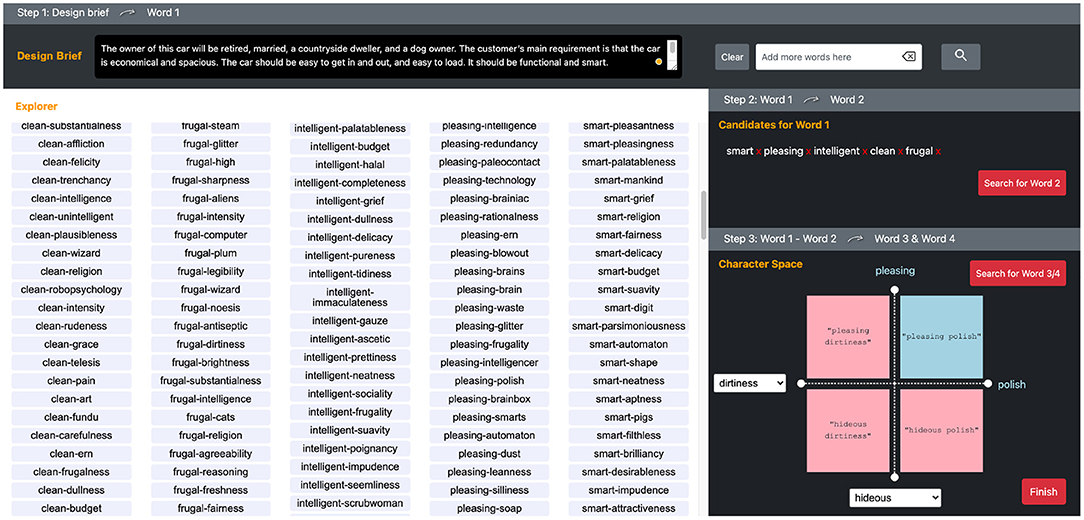
Figure 4. Web application user interface of the Character Space Construction (CSC). The top sections are the input windows for “Design Brief” and individual query words. The largest section is allocated to “Explorer,” where candidates for word 1 and word 1–word 2 compound phrases are presented. On the right sidebar, the “Candidates for Word 1” section shows the words a user selected and the “Search for Word 2” button. “Character Space” shows a quadrant system as a user chooses word 1 and word 2, that trigger to show the candidates of Word 3 and Word 4 as opposing concepts.
The middle right section is step 2, where users can choose and pool candidates for w1 and search for candidates for w2 that are combined with the w1 candidates. The users at this point will see a variety of adjective phrases (w1-w2) in the Explorer as ranked lists in columns, grouped by w1.
Finally, the lower right section is the CS, which is a quadrant system with all four words set at the ends of each axis. The first quadrant of the CS is set by dragging and dropping an adjective phrase chosen by the user from the lists in the Explorer. Once the user finalizes the first quadrant of the CS with adjective phrases (w1-w2) and clicks the “Search for word 3/4” button, the system will search for antonyms to w1 and w2, as w3 and w4, respectively. The candidates for w3 and w4 are shown in a pull-down menu at the end of each axis so that the user can choose a suitable contrasting word for each w1 and w2 to complete the CS. The upper right quadrant, represented by the combination of w1 and w2, is the target design-concept phrase. All the other quadrants, represented by w2-w3, w3-w4, and w4-w1, are contrasting concepts to be used by the participants to explain the target design concepts in comparison with opposing concepts. After clicking on the “Finish” button, the system generates an explanation of the DCP as a template matched sentence, like “My design concept is w1-w2. It has a sense of w2 yet is w1, not w3. It is w1 but not w4. In this design, w1 and w2 can go together.” Algorithm 1 illustrates the procedure described above. Table 1 shows brief explanations of each sub-function in Algorithm 1.
For the function CalculateWordScore, the preliminary study gave us an opportunity to observe a list of randomly chosen adjectives. Despite being extracted from the domain-specific corpus we created, the list included a considerable number of unusable adjectives. These unusable adjectives included ones with negative connotations (e.g., amateurish, costly, detrimental), temporality (e.g., first, latest, recent, subsequent), distance (e.g., far, near, close), or utilities (e.g., guest, sourced, takeaway) as well as those that were too concrete in terms of expressing visuals (e.g., square, yellow, golden), to name a few.
To rule out such unusable adjectives, we used a binary labeling (usable/unusable) for a design concept by five professional automotive designers, who were independent from this research, and we used the count of usable labels and the word embedding vectors from the ConceptNet Numberbatch (Speer et al., 2017) to form a model that predicts the usefulness score of unknown adjectives using gradient boosting (Friedman, 2001), which is a decision-tree-based ensemble machine learning algorithm. We used a Python software library called XGBoost (v0.90) (Chen and Guestrin, 2016), which uses a gradient boosting framework. We implemented a linear regression predictive model that was trained to minimize the prediction errors (RMSE) in a 10-fold cross validation that yielded the max depth of the decision tree and the learning rate as 6 and 0.05, respectively. The average RMSE of the prediction with the best hyperparameters on test data was 1.406. We used this model to predict usefulness scores for new adjectives, which were used to display the candidate adjectives for w1 in descending order.
For the function CalculatePhraseScore, we tried to replicate the predictor of the degree of creativity, which is the threshold of the similarity of two words, from the related works on combinational creativity (Han et al., 2018, 2019), which demonstrated that noun-noun combinations that represent good (award-winning) design concepts fell into a certain range of distance between two nouns. However, our test with five professional automotive designers on adjective phrases in terms of creativity with pre-calculated similarity did not show a clear normal distribution in the scores to determine a threshold. Yet, some brackets for similarity showed better or worse scores than the others, so we assigned these scores to unknown adjective phrases in accordance with the calculated similarity values for each instance. These phrase scores were used to display the candidate phrases for w1-w2 in descending order.
4. Experiment Design
4.1. Participants and Independent Variables
The study protocols below have been approved by the Institutional Review Board of the National Institute of Informatics, Tokyo, Japan on February 15th, 2021 (Approval number 0042).
One hundred and seventy-two participants, whose job function was arts and design and who were fluent in English, were recruited via Prolific, an online user test participant recruiting service. Seventeen duplicate participants were removed. Of the 155 non-duplicate participants, 15 (9.68%) withdrew due to system trouble, and 37 (33.55%) did not complete the study for unknown reasons. The withdrawal rate was high due to the complex and time-consuming nature of the task. That left us with a total of 103 participants (54 M, 49 F) who completed the study, with a mean age of 28.1 years (σ = 8.51).
We recruited professional designers who would utilize the tool, instead of recruiting potential end users who would consume the product, because as discussed in Section 2.4, the present research focuses on an evaluation of a creative support tool (CST), most commonly defined as tools to make more people more creative more often (Shneiderman, 2002).
All of the participants who completed the study used either laptops or desktop computers of their own. The participants who completed the study were paid US$15. The independent variables differed by whether or not the participants used the CSC system (Figure 4). When not using the CSC, the participants were given complete freedom to use any publicly available web search tools, such as Google search, an online thesaurus, or Wikipedia. All of the participants were asked to perform the same task twice with (experiment) and without (control) the CSC system. The order of the tool they used in two tasks was assigned randomly in a counterbalanced order. They were given different design briefs (Table 2) for each task to mitigate a learning effect, however, we deemed those two design briefs equivalent in terms of influences on the results for the following rationals. First, both briefs share the domain of the products (automotive products), and the basic component of the design briefs: target audience, the context of the product in use, and expected features. Second, the textual stimuli in both design briefs are described in the same abstraction levels. Gonalves et al. (2012) reported although different visual stimuli strongly provoked different outcomes, difference in textual stimuli did not show significant difference in the outcomes, unless they are substantially different in specificity of domain, level of abstraction, and the distance between the baseline and the supplemental briefs.
We did not offer a blank CS for the control participants because using the CS is a part of our proposed method. The participants in the control group were given instructions and an example of how to generate an explanation of their DCPs. They participated in the experiment online using Survey Monkey, an online platform, to which the participants were redirected from the recruiting service, Prolific. Each participant was given Supplementary Video instructions explaining the goal of the task and how to use the CSC tool (experiment group only) before the task. The CSC tool was given to the experiment group with a URL link.
4.2. Stimuli and Tasks
After reading a brief, the participants were prompted to start the task. Those with the experiment condition (CSC tool) was instructed to start the task by copying and pasting the design brief to the CSC tool, and as described in Section 3.3, the CSC system provides a search window in which the participant can input queries in case they did not find any word that they wanted to use in the Explorer.
For both experiment and control conditions, there were two tasks. The first task was “to create a unique and original DCP as an adjective-noun phrase form that will inspire the audience (described in the design brief) to imagine the character of the design.” “Effortless elegance” was given to the participants as an example of an adjective phrase in the instruction Supplementary Video. The second task was to explain their own DCP with contrasting words. As an example, the adjective “uneasy” and the noun “clumsiness” were presented as contrasting words for “effortless” and “elegance,” respectively. An example of an explanation sentence was also given as follows: “My design concept is ‘effortless elegance.' It has a sense of elegance, yet it is effortless, not uneasy. It is effortless but not clumsy. In this design, effortless and elegance can go together.”
For the experiment condition, this explanation was generated automatically using all w1 through w4 using template matching as long as they completed the CSC properly, and the CSC provided a “copy” button that allowed the participants to copy the automatically generated explanation to the clipboard so that they could paste it into the survey. However, they were also given the freedom of editing it in the survey questionnaire. The participants with the control condition had to generate and write an explanation down in the survey questionnaire on their own, however, they were also provided exactly the same example paragraph described above. In the experiment condition, participants were also given a unique session ID by the CSC system so that we could match the system log to examine how each participant interacted with the words and phrases.
4.3. Evaluation Method
As discussed in Section 2.4, we used the CSI (Cherry and Latulipe, 2014) as a post-task psychometric measurement to compare two conditions, with (experiment) or without (control) the CSC, in terms of creativity support. The CSI enables us to quantify the cognitive processes of users using psychometric scales for six factors: Exploration, Expressiveness, Immersion, Enjoyment, Results Worth Effort, and Collaboration (Table 4). The CSI evaluates a creativity support tool itself, and focuses on the experience of using it to create rather than trying to directly evaluate a property of products. Instead, the CSI evaluates the result of a creation in relation to an effort a user made, such as “I was satisfied with what I got out of the system or tool.” This is suitable for tools designed for experienced users, who know what the creative outcomes are and what the ideal experiences in creation are, as opposed to the tools designed for novice users where creativity is not sufficient and thus needs support. The CSI also offers flexibility, such that it can be applied to various tools and scenarios over time and provides standardized measurement. It is robustly developed as each of the six factors has two different statements (Table 3) that improve the statistical power of a survey, which is deployed in the CSI. In combination with paired factor comparisons for each of the six factors (Table 4), it also provides insight into what aspects of creativity support may need attention.

Table 4. The Paired-Factor Comparison Test has 15 comparisons for each pair, a user will choose a factor description in response to the following statement: “When doing this task, it's most important that I'm able to...” (Cherry and Latulipe, 2014).
The CSI has a rigorous protocol that the researcher should follow in order for the measurement and analysis to be universal and reliable. For instance, our CSC tool is not designed for collaborative tasks; however, the CSI protocol discourages researchers from skipping the statements in the Collaboration factor, still allowing participants to rate the collaboration statements. Instead, the CSI protocol allows adding “N/A” responses to statements that belong to the collaboration factor, which we incorporated in our survey.
Also, the final CSI score will be weighted by the scores of paired-factor comparisons, so if a participant does not think of the collaboration factor as important, it is reflected in the final score accordingly. The only other modification we made was to replace “the system or tool” with “The CSC” in each statement (e.g., “I enjoyed using the CSC.”) that we were able to do so in. We asked 12 questions on how strongly they agreed or disagreed with each statement on a 10-point Likert scale after each task was completed and 15 paired-factor comparison questions at the end, emphasizing that they were comparing the factors that they thought were important for the tasks, not for the different tools. To check the reliability of each factor, we examined the similarity of the scores (Table 5) across the two different statements.
4.4. Participant Profile
Since we designed the CSC with professional designers in mind, we were interested in examining the CSI ratings depending on the years of experience and how often the participants performed the particular task we attempted to support with the CSC, that is, generating DCPs especially in the aesthetic sense and explaining them to stakeholders. For the former, we bracketed the years-of-experience groups as: <1 year, 1–3 years, 3–5 years, 5–10 years, and 10+ years. For the latter, the groups were divided as: less than quarterly or never, quarterly, monthly, weekly, and daily.
5. Results
5.1. Creativity Support Index
Table 5 shows the total CSI scores and factor scores between the experiment (CSC) group and the control group. The mean CSI score of the experiment group, which used our proposed CSC (72.03, σ = 16.67), was significantly higher (p = 0.012 < 0.05*, Cohen's d = 0.369) than that of the control group (66.32, σ = 14.22) (Figure 5, error bars show standard error). Note that four participants out of 103 were excluded due to their DCP being invalid because the compound phrase (w1-w2) was impossible to interpret, hence leaving us with 198 cases from 99 participants. Ten cases were excluded as outliers whose CSI scores were more than two standard deviations away from both sides of the mean, which left us with 188 cases (93 experiments, 95 control) for the final analysis.

Figure 5. Equation for scoring the CSI (Cherry and Latulipe, 2014).
For the reliability of the ratings within each factor, the Cronbach's alpha for Exploration, Expressiveness, Immersion, Enjoyment, Results Worth Effort, and Collaboration was 0.787, 0.843, 0.846, 0.894, 0.811, and 0.829, respectively. As for the factors of the CSC the participants found important, we compared the mean factor counts from paired factor comparisons, which were 3.8876(σ = 0.88), 3.6854(σ = 1.04), 1.7753(σ = 1.07), 2.2584 (σ = 1.36), 3.0112(σ = 1.25), and .3820(σ = 0.80), respectively.
Weighted factor scores were calculated by multiplying a participant's factor agreement rating on the statement that belongs to the factor by the factor count (Figure 6) (Cherry and Latulipe, 2014). This was done in order to make the weighted factor score more sensitive to the factors that were the most important to the given task. The weighted factor score of Exploration for the experiment group (61.91, σ = 20.6) was significantly higher (p < 0.001**, Cohen's d = 0.679) than that of the control group (51.32, σ = 18.73). The other weighted factor scores did not indicate a significant difference between the experiment and control groups. As for the perceived importance of the factors by the participants, the mean count of the factors for Exploration [3.89 (σ = 1.04)] was among the highest, and that of Collaboration [0.38 (σ = 0.8)] was among the lowest.
A partly-repeated two-way ANOVA was performed in order to check the order effects. The within-participants factor is the tool they used (CSC or control), and the between-participants factor is the order they used the tool (CSC first or control first). We report a significant order effect (p = 0.007**, F = 7.70) between CSC-first or control-first groups. As for the within-participants test, there were no significant main effect or significant interaction between the tool and the order.
5.2. CSI Score Distribution by Participants Profile
Figure 7 shows the distribution of CSI score between the CSI(experiment) group and control group by years of experience brackets in “arts and design” profession. While the years of experience was asked as a categorical choice we examined a Pearson rank correlation between the CSI score and the median rank in each bracket with respect to the years of professional experiences for each group. Weak correlations were observed between the CSI score and the years of experience for both CSC (r = 0.235, p = 0.023*) and the Control (r = 0.237, p = 0.021*) groups. This indicates that the longer the experience, the more they value the benefit of the tool they used, which is consistent in both CSC and control groups. The mean CSI scores of CSC group for: <1 year, 1–3 years, 3–5 years, 5–10 years, and 10+ years were 65.27, 69.90, 69.61, 76.41, and 76.87, respectively. The mean CSI scores of the control group for the same years-of-experience brackets were 61.54, 63.01, 65.54, 69.62, 71.98, and 66.32, respectively. As for how often the participants performed the particular task, we did not observe any such tendencies in the CSI score by the frequency of the DCP creation task they engaged in. Table 6 shows the illustrative examples of randomly selected DCPs generated by the participants per tools and design briefs.
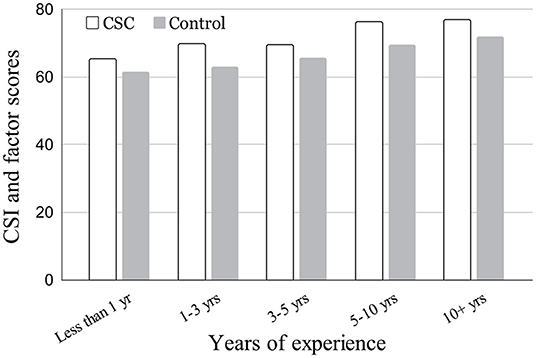
Figure 7. CSI score distribution between groups by years of experience bracket in “arts and design” profession.
6. Discussion
6.1. Contributions and Applications
The present research showed that our proposed system, CSC, demonstrated its advantage for the goal we aimed to achieve, which is to support the creativity of professional designers. Our research is motivated by an empirical observation on the characteristics of the concept designer task, that is, exploring, identifying, and communicating a design concept, especially with respect to product aesthetics and semantics, as opposed to product features and functionalities.
We took the example of the automotive industry to describe a case study because the particular characteristics of the design conceptualization task are most apparent in automotive design studios. Yet, these characteristics are common in industrial design in general, where the skills of industrial designers are highly specialized and focused. As Tovey (1992) discussed, the tasks of industrial designers are distinguished from those of their engineering colleagues, and they are specialized in determining the appearance and identity of a product. However, these practices are traditionally highly empirical, informal, undocumented, and sometimes even secretive due to the strict confidentiality of the industry. It also tends to be dependent upon the individual experiences of designers. We modeled this process as generating a compound adjective phrase that best conceptualizes the nature of the design aesthetics and semantics and then constructing a CS to explain them in contrast with an opposing or distinct concept in a quadrant system (Figure 2B). With respect to adjective phrases, as discussed in Section 1, these adjective phrases can also be used in design practices on other industries (Choo and Kim, 2003; Khalaj and Pedgley, 2014; Durán-Muñoz, 2019), in computer poetry (Toivanen et al., 2012), or even in the advertisements in tourism industry (Durán-Muñoz, 2019) where the verbal expressions of aesthetics and the semantics of the products matter. Therefore, the proposed methods can be applied to various design and new product development fields, and are likely to be optimized by introducing domain-specialized corpora for the function CalculateWordScore and the function CalculatePhraseScore. In regards to the quadrant system, there has been a vague distinction between analysis using a dimensionality reduction on multidimensional scaling (MDS) visualization technique and what designers use as a synthesis tool. We defined the latter as the CS, translated it into a computational algorithm, and implemented it in an interactive web application so that designers can effectively trace the process in an orderly sequence. Designers know what the important factors of this task are, and evidently, we confirmed that designers value the Exploration factor most in this task.
In this research, we shed light on concept designers' cognitive activities (Figure 2A), that were previously indefinite, formalized them (Figure 2B), translated them into the CSC algorithm (Algorithm 1), and created the interactive user interface (Figure 3). The theoretical contribution of the present research is based on a formalization of a designer's concept exploration activities, which involves searching and selecting a compound adjective as a DCP. This formalization of constructing a CS not only signifies the designers' process of verbal design concept explorations but also leads to subsequent visual creations (Figure 3).
As for a practical implication of the present research, experienced designers seem to have valued the structured process of forming and explaining the DCPs in the experiment. As some of the Weighted Factor Scores of CSI, such as Enjoyment and Immersion, did not seem to matter to them, the participants probably appraised the CSC as to offer them a certain efficiency and effectiveness as a tool for professional use. This factor evaluation result, with less emphasis on Enjoyment and Immersion, came in with a bit of surprise to us, however, it actually gave us an assurance that we should spend more resources to improve more Exploration factors, which we put many efforts into this research by offering a variety of words and phrases presented on the Explorer, enabled by the ConceptNet knowledge graph. Also, while a new tool often involves a novelty effect (Tsay et al., 2020), we can claim that the CSC did not introduce a notable novelty effect, as it did not show a significant difference in Enjoyment and Immersion compared with the control condition, where participants used generic tools.
Regarding the level of expertise of the target audience, about half of creativity support tools (CSTs) have no clear target level of expertise, followed by experts (33%) and novices (17%) according to Frich et al. (2019). Our proposed method is clearly targeted for the tasks of experienced designers since we observed the need for support in a particular task. In that sense, as discussed in Figure 7, though consistent between two groups, there was a tendency indicating that the more experienced the participants were, the more aware they were of the importance of the task, which suggests the necessity or usefulness of this type of creativity support tool. Meanwhile, it can be also said that, if the CSC were successfully emulating the process that an expert designer would use, we should have observed a bottom-up effect for the designers with fewer experiences. In the future, we may need to promote a method to raise the awareness of process-oriented practices for less experienced designers.
As reported in Section 5.1, we observed an order effect between the participants who used CSC first or second. The CSI score for the control tool rated by the participants who used the CSC first substantially dropped. Meanwhile, the CSI score for the CSC tool rated by the participants who used the control tool first practically stayed the same. While this may have been cased by a “fatigue effect” on repeated task (Bradley and Daly, 1994) as the tasks given to the participants were fairly complex and time consuming, it is probably a positive sign to see the CSI score which is maintained the same level when used in the second task.
6.2. Limitation
As the focus of this research was to identify and implement the design concept generation process used by designers, that is, creating DCPs and communicating them, into an algorithm for constructing the CS, there are some limitations on the CSC tool. First, we did not put much emphasis on generating the “good” results achieved by some of the related works mentioned in Section 2.3., which would have been reflected in the Result Worth Effort factor or Expressiveness of the CSI. For example, the function, CalculateWordScore and the function CalculatePhraseScore could be iterated more in optimizing the algorithms. In fact, how to optimize suggested words and phrases can be another research question, while the features and characteristics of adjectives can be identified and utilized in order to suggest words and phrases that users can find more creative. In the course of the research we have examined several potential predictors, such as adjective supersense (Tsvetkov et al., 2014), and psycholinguistic attributes of words (Wilson, 1988), however, none appeared promising. There should be more potential predictors we can investigate in the future. Second, the CSC tool focuses on verbal concept design activities and does not involve visual activities at this time. Although the verbal activity can be a starting point to conceptualize and manipulate the product aesthetics and semantics, designers will engage in visual ideation activities that can be also computationally supported. We would like to implement this visual process into the system in the future, that is, creating a mood board as we previewed an example (Figure 4), into the CS.
As for the limitation of our experiment, the participants were not given the identical design brief for each condition, however, we carefully composed both design briefs in consistent manner described in the Section 4.1, and deemed those two design briefs equivalent in terms of influences on the results. Our intention of the experiment was to compare different tools, not to compare the different stimuli though it may leave a room for discussions. Some may argue it might have been better to set up a between-participants arrangement, yet, we had to take a within-participants arrangement for two reasons: first, we were still trying to test the relative effectiveness between two conditions—the proposed method and what they usually practice in their regular works. Second, recruiting a sufficient body of participants who are in “arts and design” profession for a between-participants arrangement was prohibitively difficult.
We did not ask the participants with control conditions what web search tool(s) they actually used in creating and explaining their DCPs, in order to avoid overloading the participants with additional questions. Also, those publicly available web search tools do not provide the log data of the participants' behaviors during the search. Thus, how many and what queries the participants tried, or how many words the participant actually looked at before deciding w1 or w1−w2 combinations, for example, is unknown and we were unable to compare such interactions between the conditions.
Another factor that may affect the CSI results is the graphic user interface. Our proposed CSC tool did not suggest novelty effect indicated by rather humble Enjoyment and Immersion scores. However, it can also be said that there is a room to introduce a novelty bias if we adopt a more entertaining graphic user interface. In the future, we would also like to compare different graphic user interfaces to examine how Enjoyment and Immersion factors would interact with Exploration, Result Worth Effort, or overall CSI scores.
Lastly, despite the fact that the CSI is most commonly used to evaluate creative support tools, we acknowledge that it does not evaluate the “effectiveness” of the tool in terms of how strongly the potential end-users are influenced by the generated design concepts. As there is no one-size-fits-all approach (Hewett et al., 2005) we may also need to develop our original tool that appropriately measure the effectiveness of the creation while we implement the visual component discussed earlier in this section.
7. Conclusion
We focused on the process of verbal design concept exploration practiced by concept designers, that is, generating and verbally communicating product aesthetics and semantics, and we attempted to implement them into an algorithm. We created a system, Character Space Construction (CSC), that enables concept designers to explore and choose words to create a compound adjective phrase, which we call the Design Concept Phrase (DCP). This is a part of the process of constructing a quadrant system, which we call the Character Space (CS). In a CS, a DCP can be represented in the upper right quadrant, whereas other quadrants can be described as what to stay away from or avoid in a semantic space. Our experiment, which was done with 103 participants using a within-participants arrangement, compared our proposed methods, CSC and the general process designers use, and it was shown that our proposed method, the CSC, has a significantly positive effect using Creativity Support Index (CSI).
Data Availability Statement
The datasets presented in this study can be found in online repositories. The names of the repository/repositories and accession number(s) can be found at: https://github.com/shinsano/CSC_SourceCode **Source code** - EA.html : the main web application UI (Section 3.2) - styleshet.css : the CSS that describes how html elements are displayed on the UI (Section 3.2) - EA.js : defines and execute the front-end functions (Section 3.3) - main.py : define and execute back-end functions (Section 3.3). **Generated Data** - ExperimentAA_AN_NN_VVall_response.csv : the participants' response to compound phrases in different PoS (Section 3.1). - SingleWord_U_score.csv : the 200 adjectives labeled by expert designers for an input to the gradient boosting predicting unusable words (Section 3.3, “CalculateWordScore” function on Table 1). - Combination_rating.csv : the 130 adjective phrases rated by expert designers to assign the score for sorting new word1 - word2 combinations (Section 3.3, the function “CalculatePhraseScore” on Table 1). **Main experiment all participants responses** “FI_CSC_results10.19.2021”: https://docs.google.com/spreadsheets/d/1RhYAh00-5ABYY_QlaCYtoYnfJCFKH1gIHOfkKc3Ag7Q/edit#gid=179189720.
Ethics Statement
The studies involving human participants were reviewed and approved by the Ethical Committee (IRB) of the National Institute of Informatics. Approve number 0042. The patients/participants provided their written informed consent to participate in this study.
Author Contributions
SS contributed to the conception, design, execution of the study, performing the statistical analysis, writing the first draft, and the final version of the manuscript. SY served as the driving force behind the concept, organized the project, and provided guidance throughout the execution of the project. All authors contributed to manuscript revision, read, and approved the submitted version.
Funding
This work was partially supported by JST, CREST (JPMJCR21D4), Japan.
Conflict of Interest
SS was employed by Toyota Motor Corporation and its North American subsidiary, Calty Design Research, Inc. between April 1992 and July 2007. SS was hired as a design consultant between January 2015 and July 2020 for the Concept-i project, which is introduced as an industry case study in the introduction section of this paper. This research is independent of any part of that project and the authors received no funding for the cost of this research.
The remaining author declares that the research was conducted in the absence of any commercial or financial relationships that could be construed as a potential conflict of interest.
Publisher's Note
All claims expressed in this article are solely those of the authors and do not necessarily represent those of their affiliated organizations, or those of the publisher, the editors and the reviewers. Any product that may be evaluated in this article, or claim that may be made by its manufacturer, is not guaranteed or endorsed by the publisher.
Acknowledgments
We appreciate the support of the automotive designers at an anonymous company for cooperating with the preliminary studies on labeling adjectives and adjective phrases.
Supplementary Material
The Supplementary Material for this article can be found online at: https://www.frontiersin.org/articles/10.3389/fpsyg.2021.819237/full#supplementary-material
Abbreviations
CSC, character space construction; CS, character space; DCP, design concept phrase; CSI, creativity support index; MDS, multidimensional scaling.
Footnotes
1. ^Car Design News (2017). CES 2017: Toyota Concept-i in depth. https://www.cardesignnews.com/cdn-live/ces-2017-toyota-concept-i-in-depth/22991.article (accessed October 22, 2021).
2. ^All the images in Figure 4 are licensed under Creative Commons in either of the following conditions: CC PDM 1.0, CC BY-NC-ND 2.0, CC BY 2.0, or CC BY-SA 2.0.
References
Alcaide-Marzal, J., Diego-Mas, J. A., and Acosta-Zazueta, G. (2020). A 3D shape generative method for aesthetic product design. Des. Stud. 66, 144–176. doi: 10.1016/j.destud.2019.11.003
Bae, S. S., Kwon, O.-H., Chandrasegaran, S., and Ma, K.-L. (2020). “Spinneret: aiding creative ideation through non-obvious concept associations,” in Proceedings of the 2020 CHI Conference on Human Factors in Computing Systems (Honolulu, HI), 1–13. doi: 10.1145/3313831.3376746
Barron, F. (1955). The disposition toward originality. J. Abnorm. Soc. Psychol. 51:478. doi: 10.1037/h0048073
Bloch, P. H., Brunel, F. F., and Arnold, T. J. (2003). Individual differences in the centrality of visual product aesthetics: concept and measurement. J. Consum. Res. 29, 551–565. doi: 10.1086/346250
Boden, M. (2001). “Creativity and knowledge,” in Creativity in Education, eds A. Craft, B. Jeffrey, and M. Leibling (London: Continuum), 95–102.
Bouchard, C., Camous, R., and Aoussat, A. (2005). Nature and role of intermediate representations (IR) in the design process: case studies in car design. Int. J. Vehicle Des. 38, 1–25. doi: 10.1504/IJVD.2005.006602
Bradley, M., and Daly, A. (1994). Use of the logit scaling approach to test for rank-order and fatigue effects in stated preference data. Transportation 21, 167–184. doi: 10.1007/BF01098791
Bruner, J. S. (1962). “The conditions of creativity,” in Contemporary Approaches to Creative Thinking, 1958 (Boulder, CO: University of Colorado, Atherton Press). doi: 10.1037/13117-001
Chen, T., and Guestrin, C. (2016). “Xgboost: a scalable tree boosting system,” in Proceedings of the 22nd ACM SIGKDD International Conference on Knowledge Discovery And Data Mining (San Francisco, CA), 785–794. doi: 10.1145/2939672.2939785
Chen, T.-J., Subramanian, S. G., and Krishnamurthy, V. R. (2019). “Mini-map: mixed-initiative mind-mapping via contextual query expansion,” in AIAA Scitech 2019 Forum (San Diego, CA), 2347. doi: 10.2514/6.2019-2347
Cherry, E., and Latulipe, C. (2014). Quantifying the creativity support of digital tools through the creativity support index. ACM Trans. Comput. Hum. Interact. 21, 1–25. doi: 10.1145/2617588
Chiu, I., and Shu, L. H. (2012). Investigating effects of oppositely related semantic stimuli on design concept creativity. J. Eng. Des. 23, 271–296. doi: 10.1080/09544828.2011.603298
Choo, S., and Kim, Y. (2003). Effect of color on fashion fabric image. Color Res. Appl. 28, 221–226. doi: 10.1002/col.10147
Demirbilek, O., and Sener, B. (2003). Product design, semantics and emotional response. Ergonomics 46, 1346–1360. doi: 10.1080/00140130310001610874
Desmet, P. M., and Hekkert, P. (2002). “The basis of product emotions,” in Pleasure With Products, Beyond Usability, eds W. Green and P. Jordan, 60–68.
Dong, A. (2005). The latent semantic approach to studying design team communication. Des. Stud. 26, 445–461. doi: 10.1016/j.destud.2004.10.003
Durán-Mu noz, I. (2019). Adjectives and their keyness: a corpus-based analysis of tourism discourse in English. Corpora 14, 351–378. doi: 10.3366/cor.2019.0178
Frich, J., MacDonald Vermeulen, L., Remy, C., Biskjaer, M. M., and Dalsgaard, P. (2019). “Mapping the landscape of creativity support tools in HCI,” in Proceedings of the 2019 CHI Conference on Human Factors in Computing Systems (Glasgow, UK), 1–18. doi: 10.1145/3290605.3300619
Friedman, J. H. (2001). Greedy function approximation: a gradient boosting machine. Ann. Stat. 29, 1189–1232. doi: 10.1214/aos/1013203451
Georgiev, G. V., Nagai, Y., and Taura, T. (2010). A method for the evaluation of meaning structures and its application in conceptual design. J. Des. Res. 8, 214–234. doi: 10.1504/JDR.2010.032607
Gonalves, M., Cardoso, C., and Badke-Schaub, P. (2012). “Find your inspiration: exploring different levels of abstraction in textual stimuli,” in DS 73-1 Proceedings of the 2nd International Conference on Design Creativity, Vol. 1 (Glasgow, UK).
Han, J., Forbes, H., and Schaefer, D. (2021). An exploration of how creativity, functionality, and aesthetics are related in design. Res. Eng. Des. 24, 1–19. doi: 10.1007/s00163-021-00366-9
Han, J., Hua, M., Park, D., Wang, P., and Childs, P. (2020). “Computational conceptual distances in combinational creativity,” in Proceedings of the Design Society: DESIGN Conference, Vol. 1 (Cambridge, GB: Cambridge University Press), 177–186. doi: 10.1017/dsd.2020.36
Han, J., Park, D., Shi, F., Chen, L., Hua, M., and Childs, P. R. (2019). Three driven approaches to combinational creativity: problem-, similarity-and inspiration-driven. Proc. Instit. Mech. Eng. Part C 233, 373–384. doi: 10.1177/0954406217750189
Han, J., Shi, F., and Childs, P. (2016). “The combinator: a computer-based tool for idea generation,” in DS 84: Proceedings of the DESIGN 2016 14th International Design Conference (Dubrovnik), 639–648.
Han, J., Shi, F., Park, D., Chen, L., and Childs, P. (2018). “The conceptual distances between ideas in combinational creativity,” in DS 92: Proceedings of the DESIGN 2018 15th International Design Conference (Dubrovnik), 1857–1866. doi: 10.21278/idc.2018.0264
Helander, M. G., Khalid, H. M., Lim, T. Y., Peng, H., and Yang, X. (2013). Emotional needs of car buyers and emotional intent of car designers. Theor. Issues Ergon. Sci. 14, 455–474. doi: 10.1080/1463922X.2012.656152
Hewett, T., Czerwinski, M., Terry, M., Nunamaker, J., Candy, L., Kules, B., and Sylvan, E. (2005). “Creativity support tool evaluation methods and metrics,” in Creativity Support Tools (Washington, DC), 10–24.
Hsiao, K.-A., and Chen, L.-L. (2006). Fundamental dimensions of affective responses to product shapes. Int. J. Indus. Ergon. 36, 553–564. doi: 10.1016/j.ergon.2005.11.009
Jakubíček, M., Kilgarriff, A., Kovář, V., Rychlý, P., and Suchomel, V. (2013). “The tenten corpus family,” in 7th International Corpus Linguistics Conference CL (Valladolid), 125–127.
Khalaj, J., and Pedgley, O. (2014). Comparison of semantic intent and realization in product design: a study on high-end furniture impressions. Int. J. Des. 8, 79–96.
Kilgarriff, A., Rychly, P., Smrz, P., and Tugwell, D. (2004). “The sketch engine,” in Proceedings of the 11th EURALEX International Congress, eds G. Williams and S. Vessier (Lorient: Université de Bretagne-Sud, Faculté des lettres et des sciences humaines) 105–115.
Koronis, G., Silva, A., and Kang, J. (2018). “The impact of design briefs on creativity: a study on measuring student designers outcomes,” in DS 92: Proceedings of the DESIGN 2018 15th International Design Conference (Dubrovnik), 2461–2472. doi: 10.21278/idc.2018.0328
Krippendorff, K. (2005). The Semantic Turn: A New Foundation for Design. Boca Raton, FL: CRC Press. doi: 10.4324/9780203299951
McDonagh, D., Bruseberg, A., and Haslam, C. (2002). Visual product evaluation: exploring users' emotional relationships with products. Appl. Ergon. 33, 231–240. doi: 10.1016/S0003-6870(02)00008-X
Nagai, Y., and Noguchi, H. (2003). An experimental study on the design thinking process started from difficult keywords: modeling the thinking process of creative design. J. Eng. Des. 14, 429–437. doi: 10.1080/09544820310001606911
Nagai, Y., Taura, T., and Mukai, F. (2009). Concept blending and dissimilarity: factors for creative concept generation process. Design Stud. 30, 648–675. doi: 10.1016/j.destud.2009.05.004
Nagamachi, M. (1995). Kansei engineering: a new ergonomic consumer-oriented technology for product development. Int. J. Indus. Ergon. 15, 3–11. doi: 10.1016/0169-8141(94)00052-5
Norman, D. A. (2004). Emotional Design: Why We Love (Or Hate) Everyday Things. New York, NY: Basic Civitas Books.
Osgood, C. E., Suci, G. J., and Tannenbaum, P. H. (1957). The Measurement of Meaning. Champaign, IL: University of Illinois press.
Phillips, P. L. (2004). Creating the Perfect Design Brief: How to Manage Design for Strategic Advantage. New York, NY: Skyhorse Publishing Inc.
Ramsay, J. O. (1975). Solving implicit equations in psychometric data analysis. Psychometrika 40, 337–360. doi: 10.1007/BF02291762
Runco, M. A., and Jaeger, G. J. (2012). The standard definition of creativity. Creat. Res. J. 24, 92–96. doi: 10.1080/10400419.2012.650092
Shieh, M. D., Wang, T. H., and Yang, C. C. (2011). Affective response dimension selection for product design: a comparison of cluster analysis and procrustes analysis. Int. J. Digit. Content Technol. Appl. 5, 305–318. doi: 10.4156/jdcta.vol5.issue1.33
Shneiderman, B. (2002). Creativity support tools. Commun. ACM 45, 116–120. doi: 10.1145/570907.570945
Speer, R., Chin, J., and Havasi, C. (2017). “ConceptNet 5.5: an open multilingual graph of general knowledge,” in Thirty-First AAAI Conference on Artificial Intelligence (San Francisco, CA).
Stein, M. I. (1953). Creativity and culture. J. Psychol. 36, 311–322. doi: 10.1080/00223980.1953.9712897
Toivanen, J., Toivonen, H., Valitutti, A., and Gross, O. (2012). “Corpus-based generation of content and form in poetry,” in Proceedings of the Third International Conference on Computational Creativity (Dublin: University College Dublin).
Tovey, M. (1992). Intuitive and objective processes in automotive design. Des. Stud. 13, 23–41. doi: 10.1016/0142-694X(92)80003-H
Trochim, W. M. (1989). An introduction to concept mapping for planning and evaluation. Eval. Prog. Plann. 12, 1–16. doi: 10.1016/0149-7189(89)90016-5
Tsay, C. H.-H., Kofinas, A. K., Trivedi, S. K., and Yang, Y. (2020). Overcoming the novelty effect in online gamified learning systems: an empirical evaluation of student engagement and performance. J. Comput. Assist. Learn. 36, 128–146. doi: 10.1111/jcal.12385
Tsvetkov, Y., Schneider, N., Hovy, D., Bhatia, A., Faruqui, M., and Dyer, C. (2014). “Augmenting English adjective senses with supersenses,” in Proceedings of the Ninth International Conference on Language Resources and Evaluation (LREC'14) (Reykjavik: European Language Resources Association (ELRA)), 4359–4365. Available online at: http://www.lrec-conf.org/proceedings/lrec2014/pdf/1096_Paper.pdf
Wilson, M. (1988). MRC psycholinguistic database: machine-usable dictionary, version 2.00. Behav. Res. Methods Instrum. Comput. 20, 6–10. doi: 10.3758/BF03202594
Keywords: intelligent interactive system, concept design, product semantics, industrial design (ID), human-computer interaction (HCI), creativity support tools (CSTs), lexical semantic, design aesthetics
Citation: Sano S and Yamada S (2022) AI-Assisted Design Concept Exploration Through Character Space Construction. Front. Psychol. 12:819237. doi: 10.3389/fpsyg.2021.819237
Received: 21 November 2021; Accepted: 31 December 2021;
Published: 27 January 2022.
Edited by:
Marko Tkalcic, University of Primorska, SloveniaReviewed by:
Ji Han, University of Liverpool, United KingdomCynthia Whissell, Laurentian University, Canada
Copyright © 2022 Sano and Yamada. This is an open-access article distributed under the terms of the Creative Commons Attribution License (CC BY). The use, distribution or reproduction in other forums is permitted, provided the original author(s) and the copyright owner(s) are credited and that the original publication in this journal is cited, in accordance with accepted academic practice. No use, distribution or reproduction is permitted which does not comply with these terms.
*Correspondence: Shin Sano, c3Nhbm9AbmlpLmFjLmpw
 Shin Sano
Shin Sano Seiji Yamada
Seiji Yamada